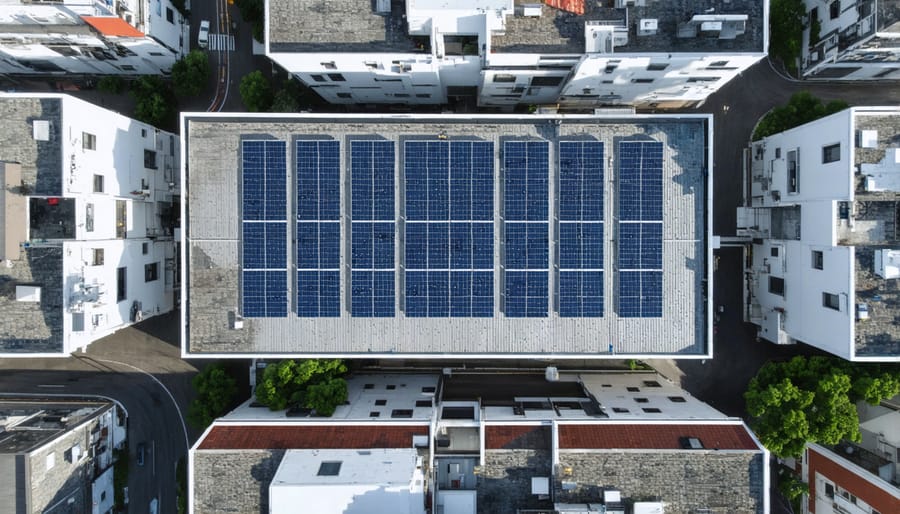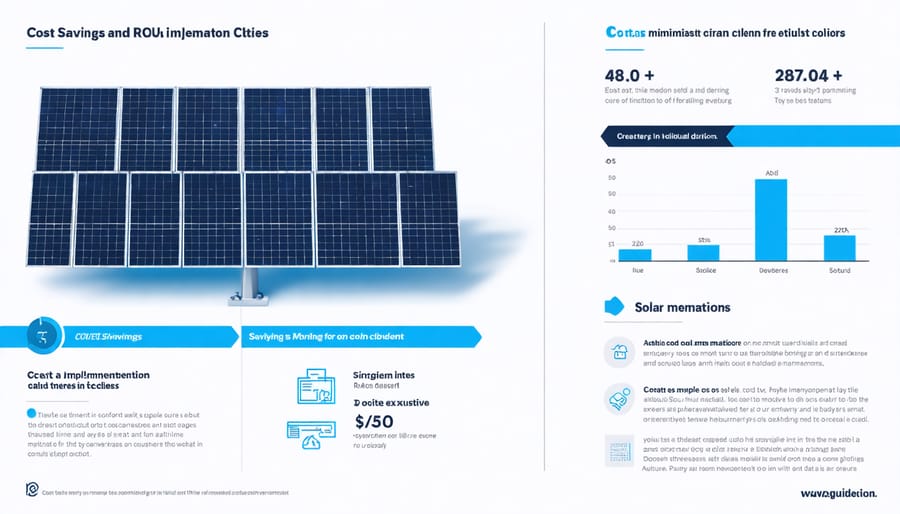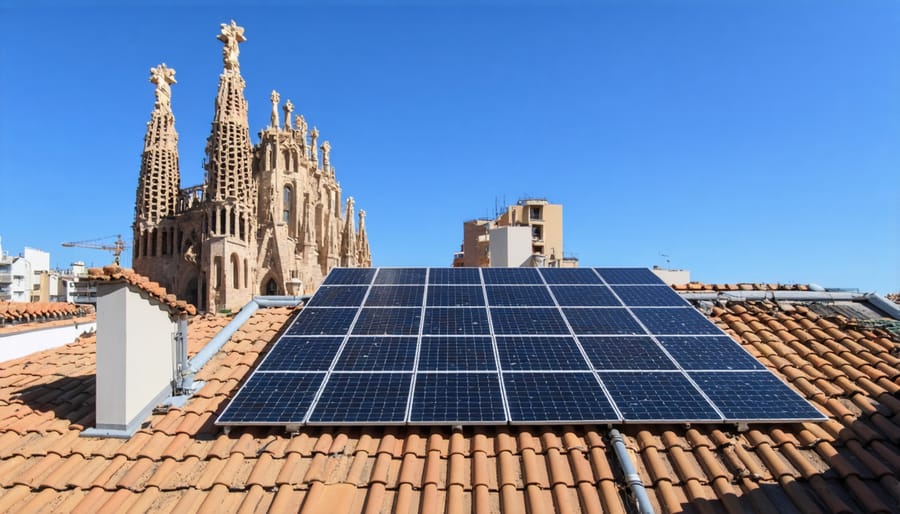As cities worldwide grapple with rising energy demands and environmental challenges, solar-powered urban infrastructure is emerging as a transformative solution for sustainable development. From Singapore’s floating solar farms to Melbourne’s complete transition to renewable energy, metropolitan areas are harnessing solar power at an unprecedented scale, reducing both carbon emissions and operational costs.
The integration of solar technology into urban environments represents more than just environmental stewardship – it’s a strategic imperative for modern cities facing increasing pressure to ensure energy security and economic resilience. Advanced solar installations, including building-integrated photovoltaics (BIPV), smart microgrids, and community solar projects, are revolutionizing how cities generate and distribute power while creating new opportunities for economic growth and community development.
Leading municipalities are demonstrating that solar-powered cities aren’t just a futuristic concept but a present-day reality. These pioneering projects combine innovative financing mechanisms, public-private partnerships, and cutting-edge technology to achieve remarkable results: reduced energy costs, enhanced grid reliability, and significant progress toward climate action goals. As urban populations continue to grow, solar power stands as a cornerstone of sustainable urban development, offering a blueprint for cities worldwide to build resilient, energy-independent communities.
The Architecture of Solar Cities

Building-Integrated Photovoltaics
Building-integrated solar panels represent a breakthrough in urban solar implementation, seamlessly combining energy generation with architectural design. This innovative approach incorporates photovoltaic materials directly into building components, including windows, facades, roofing materials, and skylights.
Modern BIPV solutions offer multiple advantages over traditional solar installations. They reduce overall construction costs by replacing conventional building materials, maximize available space in dense urban environments, and maintain aesthetic appeal while generating clean energy. For example, solar glass windows can generate electricity while providing natural lighting and thermal insulation, effectively serving triple duty in modern buildings.
Leading cities like Amsterdam and Singapore have successfully implemented BIPV in commercial buildings, achieving energy cost reductions of 30-40% while maintaining architectural integrity. The Dubai Future Foundation building demonstrates how solar facades can generate up to 25% of a structure’s energy needs without compromising design excellence.
Recent technological advances have improved BIPV efficiency and durability, making these solutions increasingly attractive for new construction and retrofitting projects. With costs continuing to decrease and performance improving, BIPV systems are becoming a cornerstone of sustainable urban development, offering building owners both immediate energy savings and long-term property value appreciation.
Smart Grid Integration
Smart grid integration represents a crucial component in the development of solar-powered cities, enabling seamless coordination between solar energy systems and existing power infrastructure. Advanced metering infrastructure (AMI) and sophisticated control systems work together to balance power generation, storage, and distribution across urban areas.
These intelligent networks continuously monitor electricity demand and supply, automatically adjusting power flow to maintain grid stability. When solar production peaks during daylight hours, smart grids can efficiently distribute excess energy to high-demand areas or direct it to storage systems for later use. This dynamic load management helps prevent grid overload and ensures reliable power delivery throughout the city.
Grid-edge technologies, including smart inverters and power electronics, enable two-way communication between solar installations and utility operators. This bidirectional capability allows for real-time monitoring and remote management of distributed energy resources, optimizing overall grid performance and reliability.
Cities implementing smart grid integration have reported significant improvements in energy efficiency and grid resilience. For example, Copenhagen’s smart grid system has reduced power outages by 20% while accommodating a 40% increase in solar capacity. Similar success stories from Barcelona and Singapore demonstrate how intelligent grid management supports the scaling of urban solar installations while maintaining power quality and system stability.
The integration process typically involves upgrading existing infrastructure with digital sensors, automated controls, and advanced communication systems, creating a more responsive and efficient urban energy network.
Economic Benefits for Urban Communities

Municipal Cost Reduction
Municipal governments implementing solar power systems consistently report significant cost reductions across multiple operational areas. The most immediate impact is seen in reduced electricity bills for public facilities, with many cities reporting 40-70% savings on their energy costs within the first year of implementation.
For example, Lancaster, California, has saved approximately $450,000 annually on municipal energy costs after installing solar panels on city buildings, schools, and community centers. These savings extend beyond direct energy costs, as solar installations typically require minimal maintenance and have operational lifespans of 25-30 years, reducing long-term infrastructure expenses.
Cities also benefit from decreased grid dependency and enhanced energy security. During peak demand periods, solar-powered facilities can operate independently, reducing strain on the municipal grid and avoiding premium rates charged during high-usage times. Some municipalities have implemented smart grid technologies alongside solar installations, enabling them to optimize energy distribution and further reduce operational costs.
Additional cost benefits come through various federal and state incentives. The Investment Tax Credit (ITC) allows municipalities to partner with private entities to finance solar projects, while grants and renewable energy credits provide additional revenue streams. Cities like Austin, Texas, have leveraged these programs to fund extensive solar initiatives while maintaining budget neutrality.
Furthermore, municipalities are finding innovative ways to monetize their solar investments. Excess energy generated by municipal solar installations can be sold back to the grid, creating new revenue streams. Some cities have established community solar programs, allowing residents to purchase shares in municipal solar projects, which both generates income and reduces project costs through community investment.
Business and Residential Returns
The financial advantages of solar power implementation in urban environments extend across both commercial and residential sectors, offering compelling returns on investment. Businesses can significantly reduce operational costs through solar adoption, with many commercial installations achieving payback periods of 3-7 years, followed by decades of reduced energy expenses. Large-scale commercial installations can transform buildings into power plants, generating excess energy that can be sold back to the grid.
For commercial properties, solar installations typically deliver 15-20% internal rate of return (IRR), outperforming many traditional investments. Additional benefits include enhanced property values, with studies showing that solar-equipped commercial buildings command premium prices and higher occupancy rates. Tax incentives and depreciation benefits further improve the financial equation for businesses.
Residential solar adoption presents equally attractive returns. Homeowners can expect to reduce their electricity bills by 50-90%, depending on system size and local solar conditions. The average residential solar system pays for itself within 5-8 years, while increasing property values by 3-4%. Modern financing options, including solar leases and power purchase agreements (PPAs), have made residential solar installations more accessible, eliminating upfront costs while delivering immediate savings.
Both sectors benefit from various government incentives, including tax credits, rebates, and feed-in tariffs. Additionally, the implementation of smart metering and energy management systems maximizes returns by optimizing energy consumption patterns and storage solutions. As technology costs continue to decrease and energy prices rise, the financial case for solar power in urban environments becomes increasingly compelling.
Real-World Success Stories
European Solar City Models
Several European cities have emerged as pioneers in solar power integration, setting benchmarks for urban solar implementation worldwide. Amsterdam stands out with its comprehensive “Solar City” initiative, which has successfully installed over 100,000 solar panels across residential and commercial buildings. The city’s innovative approach includes community solar projects and floating solar installations on urban water bodies.
Freiburg, Germany, often called the “Solar City,” demonstrates excellence in solar integration through its Solar Settlement district, featuring 59 plus-energy houses that generate more power than they consume. The city’s commitment extends to industrial zones, where large-scale solar installations power manufacturing facilities and business parks.
Barcelona has revolutionized urban solar adoption through its “Solar Ordinance,” mandating solar thermal systems in new buildings and major renovations. This policy has resulted in over 90,000 square meters of solar thermal collectors, significantly reducing the city’s carbon footprint.
In Malmö, Sweden, the Western Harbour district showcases how industrial brownfields can be transformed into sustainable communities powered by solar energy. The district combines photovoltaic panels with other renewable sources, achieving near energy autonomy.
These cities demonstrate that successful solar implementation requires a combination of progressive policies, community engagement, and innovative technological solutions. Their achievements serve as practical blueprints for other municipalities considering large-scale solar adoption.

Global Implementation Strategies
Cities worldwide have demonstrated diverse and effective approaches to solar power implementation, offering valuable lessons for urban centers considering similar transitions. Barcelona’s Solar Thermal Ordinance, mandating solar water heating systems in new buildings, has become a model policy replicated across Spain and beyond, reducing energy costs by 60% in participating structures.
Singapore’s “SolarNova” program showcases successful public-private partnerships, utilizing available rooftop space on government buildings to generate solar power. The initiative has exceeded its initial targets, installing over 200 megawatts of solar capacity across public housing developments and government facilities.
Adelaide, Australia, demonstrates the effectiveness of community engagement through its Solar City Program. By combining educational initiatives with financial incentives, the city achieved 30% residential solar adoption, one of the highest rates globally. Their approach particularly excels in integrating solar technologies with smart grid systems.
Tokyo’s strategic implementation focuses on commercial districts, where innovative solar technologies are incorporated into building facades and windows. This approach maximizes limited space while maintaining aesthetic standards, achieving a 23% reduction in commercial energy consumption.
Copenhagen’s integrated approach combines solar installations with other renewable technologies, creating a complementary energy system. Their success lies in comprehensive urban planning that considers solar potential during initial development phases, ensuring optimal positioning and efficiency of installations.
Implementation Roadmap
Planning and Assessment
The transition to a solar-powered city begins with comprehensive planning and assessment phases that establish the foundation for successful implementation. Initially, city planners must conduct detailed solar resource assessments to evaluate the area’s solar potential, considering factors such as annual sunlight hours, seasonal variations, and geographical constraints.
A crucial component is the city-wide energy audit, which identifies current consumption patterns, peak demand periods, and potential energy efficiency improvements. This data helps determine the required solar capacity and optimal placement of installations. Urban planners often integrate biophilic solar design principles to maximize both energy generation and environmental benefits.
The assessment phase must also include infrastructure evaluation, examining the existing power grid’s capacity for renewable integration, and identifying necessary upgrades. Financial modeling and cost-benefit analyses are essential to determine project viability and secure funding sources. Stakeholder engagement plans should be developed early, ensuring community support and addressing potential concerns before implementation begins.
These initial steps create a robust framework for the subsequent phases of solar city development, setting realistic timelines and measurable objectives for the transition.
Execution and Maintenance
Successful implementation of solar-powered city initiatives requires a well-structured execution strategy and robust maintenance framework. Cities typically begin with pilot programs in specific districts before expanding citywide, allowing for testing and optimization of systems. Installation phases are carefully coordinated with utility companies and local contractors to minimize disruption to existing infrastructure.
Maintenance protocols focus on regular monitoring through smart grid systems, which track performance metrics and energy production in real-time. Professional teams conduct quarterly inspections of solar installations, ensuring optimal panel alignment, cleaning schedules, and prompt repairs when needed. Weather monitoring systems help predict maintenance needs and protect equipment during severe conditions.
Data management plays a crucial role, with cities implementing sophisticated software platforms to analyze energy production, consumption patterns, and system efficiency. Many municipalities establish dedicated solar maintenance departments or partner with specialized contractors for ongoing operations. Training programs for local technicians ensure a qualified workforce for long-term system upkeep.
Cost-effective maintenance strategies include automated cleaning systems, drone inspections, and predictive maintenance algorithms that identify potential issues before they become critical. These approaches help maximize system longevity and maintain optimal energy production levels throughout the installation’s lifecycle.
The transition to solar-powered cities represents not just an environmental imperative but a strategic opportunity for urban development in the 21st century. As demonstrated by successful implementations worldwide, solar technology has matured to become both technically viable and economically advantageous for large-scale urban deployment.
For urban planners and city officials, the time to act is now. The convergence of falling solar panel costs, improved energy storage solutions, and innovative financing models has created an unprecedented opportunity to transform our urban landscapes into sustainable powerhouses. Cities that embrace solar energy today will be better positioned to meet future energy demands, attract sustainable businesses, and provide residents with cleaner, more affordable power.
To successfully implement solar initiatives, decision-makers should focus on developing comprehensive strategies that incorporate both centralized and distributed solar systems, update building codes to support solar integration, and create incentive programs for private sector participation. Collaboration between government agencies, utilities, and private stakeholders is essential for creating the necessary framework for widespread solar adoption.
The path forward requires bold leadership and strategic planning. Urban leaders must prioritize solar infrastructure in their development plans, allocate resources for implementation, and establish clear metrics for success. By taking decisive action today, cities can secure their energy future while setting an example for sustainable urban development worldwide.

